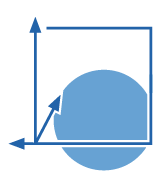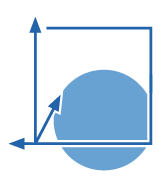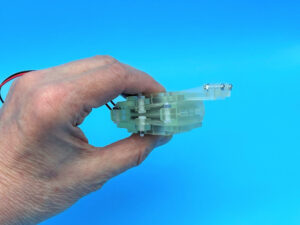For the full text, click onto the picture.
The SSP (Solid State Pump) Ventilation Systems has a surprisingly low profile of a few millimetres only and generates a high airflow of up to several cubic metres per minutes. The SSP Ventilation Systems are based on a newly developed Bucket Brigade principle and do not use any rotating parts of any kind.
Inside of an SSP Unit the airducts are built in a straight-line (from the air-inlet to the air-outlet) and the inner space is not obstructed by any object (no motor, no propeller). Therefore, foreign objects have little chance of getting jammed inside the airduct, which greatly reduces the risk of unintended system damages.
The SSP Ventilation System is powered with electricity and can be manufactured in almost any size (length). The size defines the air throughput. The user can adjust the system settings to specify the air-throughput, power consumption limits, and the start-up profile.
Bildunterschrift: SSP Ventilation System
Research is being made on the basic functionality of a new type of electromagnetic drive technology, the Magnetic Cloud Accelerator (MCA), as a joint project between Tomorrow’s Motion (TOMO) and Technical University Munich (TUM). Funding is from the Regional Department for Development and Energy of the Bavarian State Ministry for Economic Affairs.
The main objective of the joint project is to develop a comprehensive understanding and a mathematical description of the MCA. The research focus of TOMO lies in the area of test system construction, design and manufacture, as well as the provision of the measuring environment. With the co-operation of our partners EWT and TUM it will be possible to optimise design improvements in the shortest possible time.



The Professorship of Energy Conversion Technology (EWT, https://www.ei.tum.de/ewt/; head: Prof. Herzog) is a teaching and research unit in the School of Engineering and Design (until 30.09.2021: Faculty of Electrical and Computer Engineering) of the Technical University of Munich (TUM).
The EWT has been researching solutions for methodical support of the design and optimization process of electromagnetic components in mechatronic systems for years. One of the main research areas is the numerical calculation of two- or three-dimensional field problems (boundary value problems), in particular via the finite element analysis, and their connection with dynamic system simulations (initial value problems). The knowledge gained in this way at a very early stage of the project about the behavior of individual components in interaction with the overall system allows targeted extensions of the solution space. The knowledge gained with the aid of simulation is tested in a dedicated drive laboratory.
Further research areas include reliability and fault tolerance of electric drive trains, stationary inductive power transfer, and energy and power management in mobile and stationary applications.
 “As a physics student, more than 40 years ago, I invented an “engine” which has now found it’s time and place, and which I believe will play a major part in the future of our mobility: a Magnetic Cloud Acceleration (MCA) Drive Unit. These drive units are easy to build, use less raw material, and are powered by renewable electrical energy to move objects and people around either here on earth and or into outer space. We all wonder how we will be able to replace jet-engines, car combustion engines or space rockets without limiting our freedom of movement. The pollution free MCA drive invention may be the answer to so many big questions.” – Dipl.-Ing/Dipl.-Phys. Lutz A. May, CEO at Tomorrow’s Motion.
“As a physics student, more than 40 years ago, I invented an “engine” which has now found it’s time and place, and which I believe will play a major part in the future of our mobility: a Magnetic Cloud Acceleration (MCA) Drive Unit. These drive units are easy to build, use less raw material, and are powered by renewable electrical energy to move objects and people around either here on earth and or into outer space. We all wonder how we will be able to replace jet-engines, car combustion engines or space rockets without limiting our freedom of movement. The pollution free MCA drive invention may be the answer to so many big questions.” – Dipl.-Ing/Dipl.-Phys. Lutz A. May, CEO at Tomorrow’s Motion.
Read the full interview here:
https://easyengineering.eu/the-future-of-our-mobility-interview-with-tomorrows-motion/



 “As a physics student, more than 40 years ago, I invented an “engine” which has now found it’s time and place, and which I believe will play a major part in the future of our mobility: a Magnetic Cloud Acceleration (MCA) Drive Unit. These drive units are easy to build, use less raw material, and are powered by renewable electrical energy to move objects and people around either here on earth and or into outer space. We all wonder how we will be able to replace jet-engines, car combustion engines or space rockets without limiting our freedom of movement. The pollution free MCA drive invention may be the answer to so many big questions.” – Dipl.-Ing/Dipl.-Phys. Lutz A. May, CEO at Tomorrow’s Motion.
“As a physics student, more than 40 years ago, I invented an “engine” which has now found it’s time and place, and which I believe will play a major part in the future of our mobility: a Magnetic Cloud Acceleration (MCA) Drive Unit. These drive units are easy to build, use less raw material, and are powered by renewable electrical energy to move objects and people around either here on earth and or into outer space. We all wonder how we will be able to replace jet-engines, car combustion engines or space rockets without limiting our freedom of movement. The pollution free MCA drive invention may be the answer to so many big questions.” – Dipl.-Ing/Dipl.-Phys. Lutz A. May, CEO at Tomorrow’s Motion.